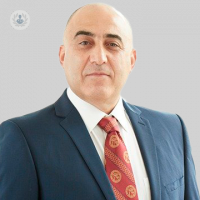Vertebroplasty
Mr Nitin Shetty - Orthopaedic surgery
Created on: 11-13-2012
Updated on: 10-06-2023
Edited by: Kate Forristal
What is vertebroplasty?
Vertebroplasty is a minimally-invasive intervention to treat acute spinal fractures. In a vertebroplasty, a cement mixture is injected into the fractured bone via a hollow needle.
Vertebroplasty is performed in a hospital or outpatient clinic. The procedure may be performed under local anaesthesia, in which case you will probably also receive medication to help you relax and feel sleepy. In some cases it may be performed under general anaesthesia.
An orthopaedic surgeon will carry out this procedure.

Why is vertebroplasty performed?
Vertebroplasty is undertaken when conventional, less-invasive treatment approaches have proven to be ineffective. These alternative treatments may include extended periods of bed rest, the utilisation of supportive back braces, the administration of pain-relieving medications, or when the use of medications has led to troublesome side effects, such as the development of ulcers or gastrointestinal problems. In cases where these initial measures do not provide adequate relief or become unsuitable due to medication-related complications, vertebroplasty is considered.
This minimally invasive surgical procedure aims to alleviate the pain and instability associated with vertebral compression fractures, often caused by osteoporosis or trauma. By injecting a specialised surgical cement into the fractured vertebra, vertebroplasty can rapidly restore vertebral integrity, reduce pain, and enhance the patient's overall quality of life.
What does the vertebroplasty procedure involve?
The vertebroplasty procedure is a meticulously orchestrated medical intervention that aims to restore structural stability to a compromised vertebra. To begin, the patient is prepped for the procedure, which typically involves administering a local anaesthetic to the affected area to minimise discomfort. Under the guidance of X-ray imaging, a skilled medical professional then carefully introduces a specialised needle into the fractured vertebra. Once the needle is precisely positioned, the surgical cement, specially formulated for this purpose, is injected in a controlled and measured manner. This cement gradually hardens within a few minutes, effectively reinforcing the weakened vertebra.
Preparation for vertebroplasty:
In the week before your procedure:
- Have a written record of the correct date, time and location of the procedure.
- Make arrangements for the return journey home after the procedure. You must not drive after the procedure. Ask a relative or friend to take you home.
- For the appointment, bring a list of your medications. Tell the doctor if you are allergic to any medications as well. Tell the doctor if you are using herbal products, nutritional supplements or over-the-counter medications.
- Consult your doctor if you have to stop using aspirin or any other medication (whether prescribed or over-the-counter) before the procedure.
- It may be necessary to undergo a spinal X-ray, a CAT scan , an MRI scan or a bone scan. You may also have to undergo blood tests before your procedure. Consult your doctor for more information about these and other examinations that you may require.
The night before the procedure:
- Ask your doctors for specific instructions concerning food and drink.
Care following a vertebroplasty:
Most people can walk after the procedure. However, you may have to remain in bed for 24 hours after the procedure; after this period, you can gradually resume everyday activities.
Many patients experience pain shortly after their vertebroplasty. The majority report that their pain has improves significantly within 48 hours.







